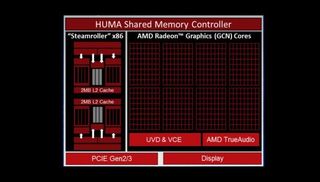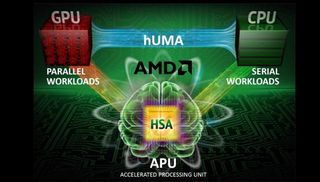AMD's FX chips return, in mobile APU form

If you'd been hoping for AMD to stick the new Steamroller cores into a new line of dedicated gaming CPUs you might well be sorely disappointed to find the new FX silicon is actually just another APU. When I say "just another APU," I am talking about the brand new mobile version of the Kaveri architecture.
AMD released the desktop version of its most advanced APU back in January at CES, but delayed the laptop version to look after its line of existing Trinity and Richland laptops, which were still selling pretty well.
That's changed, and in the coming months you should see AMD laptops with the new APU going on sale. I've spent a day in the company of an unbranded AMD notebook with the top-end FX-7600P APU in it. Because the focus of Kaveri's original design was with the mobile chip at the forefront, there isn't a lot of difference between the desktop and notebook variations of this latest APU, aside from clockspeed.
They both contain quad-core CPU configurations and the full complement of 512 Graphics Core Next GPU cores. In modern AMD parlance that gives their mobile Kaveri APU a grand total of twelve Compute Cores; that's eight GPU cores (with 64 shaders in each 'core') plus the four CPU cores.

Kaveri is the first of AMD's Heterogeneous System Architecture chips. That means both CPU and GPU share the same system memory in an equal fashion, which in turn means any software programmed with that in mind will be able to execute code on the part of the APU which will be able to run it faster. Parallel processing tasks will be run on the GPU component and serial processing on the CPU, with none of the lag associated with having to throw data into different types of graphics or system memory.
Performance
The good news: in terms of integrated graphics performance it's the most powerful mobile processor out there. I put it up against the Intel i7 4750HQ—a fully eight-threaded Haswell CPU with the top-end Iris Pro graphics - and the AMD machine beat it across my gaming benchmark suite.
Comic deals, prizes and latest news
Sign up to get the best content of the week, and great gaming deals, as picked by the editors.
The FX-7600P is only ahead by a few FPS on average, but considering the Iris Pro is only really found in £1,000 / $1500 laptops, and AMD estimates the machine I was testing would retail for around the £500 - $750 mark, the difference is pretty stark.
You wont really be happily playing on high settings at 1080p with either chip at the heart of your laptop, but make a few sacrifices in the graphics options and you'll be able to get some decent gaming performance from a thin and light machine that doesn't cost the earth.
There's also the fact that now Kaveri is using GCN cores for its graphical processing, instead of the VLIW4 architecture in the last generation of APUs. With only a little added premium to the laptop price and to the power envelope you could almost double the graphics performance by adding a little discrete GPU to your setup.

The expensive Intel chip has it all its own way when it comes to straight CPU performance; my Cinebench and X264 tests favoured the i7 by quite a margin. But because of HSA that's not the whole story anymore. There are more and more GPU accelerated applications, from web browsers, to movie makers, to image manipulation programs, which take both parts of the processor into the equation.
The latest PCMark test is a pretty decent benchmark of this, and while the i7 is some 143% quicker than the FX-7600P in the straight Cinebench CPU tests, that gap drops down to just 26% in the PCMark 8 v2 benchmark.
We should see Kaveri getting into some low-priced, thin and light laptops in the Autumn, and decent little gaming laptops could become a lot more affordable than they are right now.

Dave has been gaming since the days of Zaxxon and Lady Bug on the Colecovision, and code books for the Commodore Vic 20 (Death Race 2000!). He built his first gaming PC at the tender age of 16, and finally finished bug-fixing the Cyrix-based system around a year later. When he dropped it out of the window. He first started writing for Official PlayStation Magazine and Xbox World many decades ago, then moved onto PC Format full-time, then PC Gamer, TechRadar, and T3 among others. Now he's back, writing about the nightmarish graphics card market, CPUs with more cores than sense, gaming laptops hotter than the sun, and SSDs more capacious than a Cybertruck.
Most Popular

